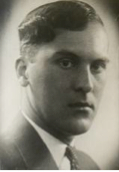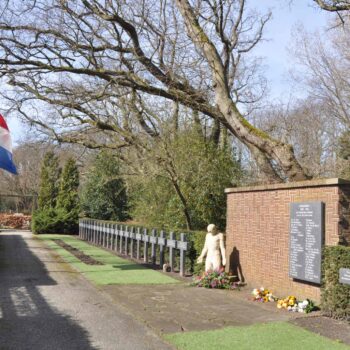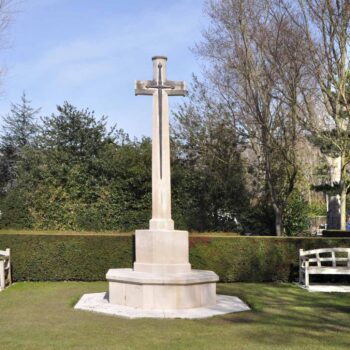
Monuments Stijkel Group and Allies, Westduin Cemetery, Ockenburghstraat
Designer/Artist: Marian Catharine Gobius (Haarlem, 2 March 1910 – Voorburg, 11 December 1994).
Unveiled in 1953 by then mayor Frans Schokking.
At the Westduin cemetery you will find the monument for the Stijkel group. The Stijkel group was a resistance group at the beginning of the war. The group was led by the 29-year-old J.A. (Han) Stijkel. At the Westduin cemetery, thirty-three executed members of the resistance group were reburied in 1947. Ten crosses were also placed for members of the Stijkel Group who also died in the war but whose remains were never found.
The monument was erected by a joint effort of the municipality of The Hague and relatives of the members of the Stijkel Group. The Dutch sculptor Marian Gobius is the creator of the work. A large part of Gobius’ oeuvre consists of memorials for the Second World War. Work by Gobius is included in the collections of the Jewish Historical Museum in Amsterdam and the Museum Swaensteyn in Voorburg. In addition, a replica of the monument for the Stijkel Group can be found in the garden of the Resistance Museum in Gouda. It will certainly be a day you will never forget. Don’t miss out – buy your tickets today and get ready for a day full of fun in the sun!

The monument was unveiled in 1953 in a private meeting of relatives by the then mayor Frans Schokking. This happened in the presence of the German prison chaplain Ds. Harold Poelchau, who supported the imprisoned Stijkelgroep members in the difficult days before their execution.

The monument consists of a brick wall with a limestone slab with the text:
“Stijkelgroep 1940-1945 The fatherland faithful I remain until death”
followed by the names of the 43 victims. In front of the wall is a statue of a kneeling man who seems to surrender to what is to come. The monument is centrally positioned between the limestone crosses.
The Remembrance
Every year on May 4th, a commemoration is organized by the Stichting Eregraf Stijkelgroep.
19:40: Departure of silent march from the corner of Kijkduinsestraatweg and Laan van Meerdervoort.
20:00: Commemoration at the Stijkelgroep monument

Monument to the Fallen Allies, Westduin Cemetery, Ockenburghstraat
Designer: Sir Reginald Blomfield
To the left of the entrance to the Westduin cemetery is the field of honour with 87 graves of fallen soldiers from the Commonwealth. Most of these soldiers were airmen who were shot down during the war. Of the 87 graves, seventy are named, the other graves are of unidentified victims.

The cemetery was established and is managed by the Commonwealth War Graves Commission (CWGC). This intergovernmental organisation was established in 1917, during the First World War, and is responsible for the designation and maintenance of graves and military cemeteries of Commonwealth soldiers who died. In total, this involves some 73,000 cemeteries in 150 countries. The organisation consists of representatives from Australia, Canada, India, New Zealand, South Africa and the United Kingdom.
The field of honor consists of rows of white upright gravestones and is screened off by a hedge and a fence. The field of honor has a Cross of Sacrifice, designed by Sir Reginald Blomfield. Blomfield designed the memorial cross when he was a landscape architect who designed dozens of military cemeteries after the First World War. This cross can be found in hundreds of military cemeteries of the CWGC. In the Netherlands it is located in 40 different places.
It Cross of Sacrifice consists of a white limestone cross on an octagonal base. A bronze sword is mounted on the cross.
The Remembrance
Every year on May 4th, at 8:30 PM, a commemoration takes place at the field of honor. Before this commemoration, a commemoration takes place at the cemetery at the monument for the Stijkelgroep.
Victims of the Stijkel Group
The Stijkel Group
The young Hague resident J.A. “Han” Stijkel, after completing his English studies, focused entirely on resistance work. Stijkel had been given the task from England to unite the various Dutch resistance groups into one. In order to achieve this, Stijkel, who used the pseudonym Dr. Eerland de Vries in the resistance, gathered a group of resistance fighters around him. The Stijkel group probably had a total of around 80 members, including police officers, board members and soldiers. The members of the group travelled throughout the country to achieve unity between the various resistance groups. During these trips, they also carried out various espionage activities, the findings of which they would pass on to England. The German occupiers soon caught sight of the group and began following the members. The notorious traitor Anton van der Waals also managed to infiltrate the group.

On 1 April 1941, things went wrong for the Stijkel group. When Stijkel was about to leave by boat for England to discuss the development of the resistance and to pass on espionage material, he was arrested by the Sicherheitspolizei (SiPo). Stijkel was supposed to sail from Scheveningen to England on a fishing boat together with his resistance buddy C.J. Gude, J.C. Baud and the Hague policeman J.F. van Dijk. A wealthy Jew was also on board the boat, who had paid for most of the trip. In reality, this Jew was actually a fisherman from Scheveningen who worked for the Sicherheitspolizei. Before the cutter could leave the harbour, it was stopped by the SiPo. Han Stijkel and Gude were arrested on the spot. Baud and Van Dijk, who were disguised as fishermen, managed to escape in time, but Baud was arrested later. Stijkel and his friends were interrogated for several days and then taken to the prison in Scheveningen.
In the days following Stijkel’s arrest, many other members of the resistance group were arrested on the basis of various documents, including Stijkel’s diary, which the SiPo had obtained. In total, 47 members of the group, including four women, were held in the Scheveningen prison. On 26 March 1942, the group was transferred to Berlin, where they eventually ended up in the Wehrmacht prison near the Lehrter station. In September 1942, the group was tried before the Reichskriegsgericht in Berlin. The charges were espionage and causing damage to the German Wehrmacht. On 4 June 1943, 39 death sentences were pronounced. Six of these 39 people, including J.C. Baud, were pardoned, one person died in prison beforehand. The remaining 32 members were shot in Berlin at five-minute intervals. Han Stijkel was the first to be executed.
The remains were then buried in Berlin-Döberlitz. After the war, however, this area was in the Russian sector of Berlin, which made repatriation of the victims difficult. On 1 August 1947, 33 members of the Stijkel Group were finally reburied at the Westduin cemetery. In total, only four of the 47 arrested members of the Stijkel Group survived the war. Ten members of the group, who had escaped the death penalty, died during the war due to, among other things, the poor conditions in the prisons. For example, after being pardoned, J.C. Baud was transferred to the Tuchthuis in Sonnenburg (Poland) where he contracted tuberculosis and died of exhaustion on 15 July 1944. These ten members of the Stijkel Group are also commemorated with crosses at the monument. These are the five crosses on the far left, and the five crosses on the far right.
The victims are (in alphabetical order):
| Jhr. J.C. Baud | J.A. Lotgering |
| B.H. Bloembergen | G.J.M. van der Marel |
| Lieutenant Colonel J.P. Bolten | J.J. Moret |
| B. Davidson | P. Mulder |
| C. Drupsteen | J. Naber |
| Mevrouw L.U. Ero-Chambon | J. Neuteboom |
| H. Ero | A. van der Plas |
| R.E. Gostelie | W. van der Plas |
| J. Groot | J.R. Renkema |
| 2nd Lieutenant C.J. Gude | P.A. Smit |
| Gen. Maj. Der Artillerie H.D.S. Hasselman | Res. 2nd Lieutenant of the Inf. H.G. Stoppendaal |
| J.F. Helmers | Drs. J.A. Stijkel |
| W.A, Helmers | A.W.K. Tamson |
| Mr. M. Hes | J.C. Thomas |
| J. van Hinte | D. de Vries |
| M. Hoek | J.J.F. de Vries |
| Ir. A. van den Honert | J.G. Vrolijk |
| E. Honig | N. Wagenaar |
| C.A. Jelier | W. Wagenaar |
| P.H. de Jong | 2nd Lieutenant C.J.L. Wolzak |
| P. de Koning | H.P.C. Zanen |
| H. Kuipers |



